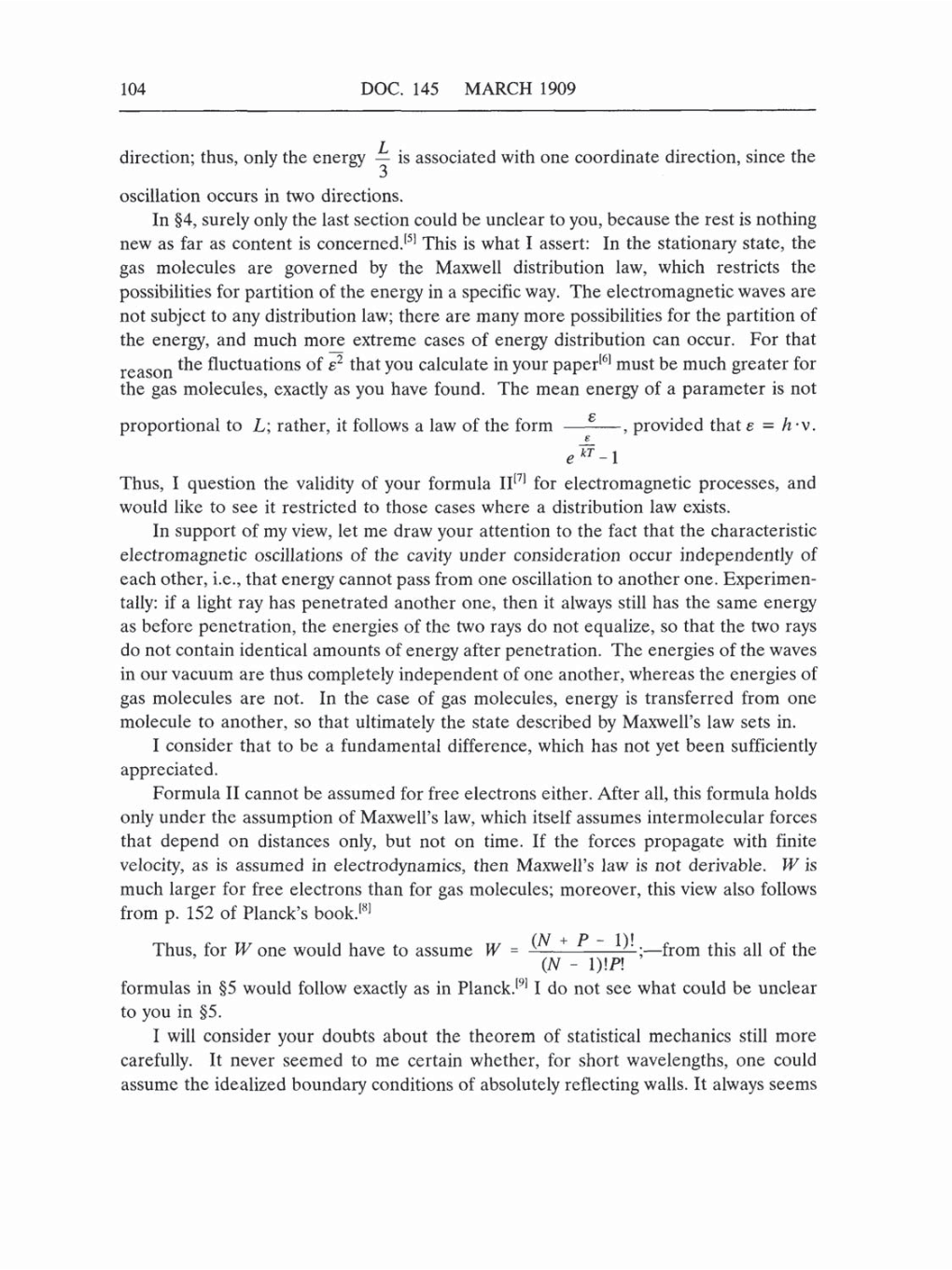104
DOC.
145
MARCH
1909
direction;
thus,
only
the
energy
L/3 is
associated with
one
coordinate
direction, since the
oscillation
occurs
in
two
directions.
In
§4, surely only
the last section could
be
unclear
to
you,
because the
rest
is nothing
new as
far
as
content
is
concerned.[5] This
is
what
I
assert:
In
the
stationary
state, the
gas
molecules
are
governed
by
the Maxwell
distribution
law,
which
restricts the
possibilities
for
partition
of the
energy
in
a specific
way.
The
electromagnetic
waves are
not
subject
to
any
distribution
law;
there
are
many
more
possibilities
for
the
partition
of
the
energy,
and
much
more
extreme
cases
of
energy
distribution
can
occur.
For that
reason
the
fluctuations
of
Ģ2
that
you
calculate
in
your
paper[6]
must be much
greater
for
the
gas
molecules,
exactly as you
have found.
The
mean energy
of
a
parameter is
not
c
proportional to
L;
rather,
it follows
a
law
of the
form
,
provided
that
s
=
h.v.
Thus,
I
question
the
validity
of
your
formula
II[7]
for
electromagnetic processes,
and
would like
to
see
it
restricted
to
those
cases
where
a
distribution
law exists.
In
support
of
my
view,
let
me
draw
your
attention
to the fact
that the characteristic
electromagnetic
oscillations
of
the
cavity
under consideration
occur
independently
of
each other,
i.e.,
that
energy
cannot
pass
from
one
oscillation
to
another
one.
Experimen-
tally:
if
a light ray
has
penetrated
another
one,
then
it
always
still has
the
same energy
as
before
penetration,
the
energies
of
the
two
rays
do
not
equalize,
so
that the
two
rays
do
not
contain
identical
amounts
of
energy
after
penetration.
The
energies
of
the
waves
in
our vacuum are
thus
completely
independent
of
one
another,
whereas the
energies
of
gas
molecules
are
not.
In the
case
of
gas
molecules,
energy
is
transferred
from
one
molecule
to another,
so
that
ultimately
the state described
by
Maxwell's law
sets in.
I
consider that
to be
a
fundamental
difference,
which has
not
yet
been
sufficiently
appreciated.
Formula II
cannot
be assumed for free
electrons either. After
all,
this
formula
holds
only
under
the
assumption
of
Maxwell's
law,
which
itself
assumes
intermolecular
forces
that
depend
on
distances
only,
but
not
on
time.
If
the forces
propagate
with finite
velocity, as
is
assumed
in
electrodynamics,
then
Maxwell's law is not derivable.
W
is
much
larger
for free electrons than
for
gas
molecules;
moreover,
this view also follows
from
p.
152
of
Planck's
book.[8]
(N
+
P
-
1)!
Thus,
for W
one
would have to
assume
W
=
-;-from
this
all
of the
(N
-
1)!P!
formulas in
§5
would follow
exactly as
in
Planck.[9] I
do not
see
what
could be
unclear
to
you
in
§5.
I
will
consider
your
doubts
about the theorem of
statistical
mechanics still
more
carefully.
It
never
seemed
to
me
certain
whether, for
short
wavelengths,
one
could
assume
the idealized
boundary
conditions of
absolutely reflecting
walls.
It
always seems
